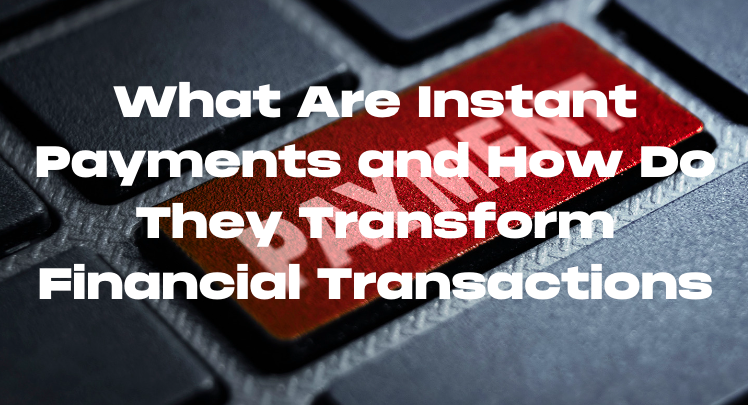In today’s digital era, where convenience and speed are paramount, traditional payment methods are gradually being replaced by innovative solutions. One such solution that has gained significant traction is instant payments. These payment systems have revolutionized the way financial transactions occur by offering immediate and seamless transfers of funds between individuals and businesses. This article explores the concept of instant payments, their underlying technologies, and the impact they have on the financial landscape.
Instant payments refer to electronic transactions that enable the immediate transfer of funds between two parties, typically facilitated through a digital platform. Unlike traditional payment methods that can take hours, if not days, for funds to be processed, instant payments allow for real-time settlement, making them ideal for time-sensitive transactions. Whether it’s splitting a restaurant bill, paying for online purchases, or settling invoices, instant payments provide the convenience and efficiency demanded by modern consumers and businesses.
To understand how instant payments work, we need to examine the underlying technology that powers them. One prominent example is the SEPA Instant Payment system, which stands for Single Euro Payments Area. SEPA Instant Payment facilitates real-time euro transfers between banks within the European Union and the European Economic Area. It enables individuals and businesses to make instant payments anytime, even outside regular banking hours.
SEPA Instant Payment operates on a 24/7 basis, allowing for immediate funds transfer at any time of the day, including weekends and holidays. This continuous availability eliminates the limitations imposed by traditional payment systems and opens up new opportunities for businesses and consumers alike. By integrating the SEPA Instant Payment system into their operations, financial institutions can offer enhanced services to their customers, fostering greater customer satisfaction and loyalty.
The introduction of instant payments brings various benefits to individuals and businesses. For consumers, instant payments offer greater convenience and flexibility. They no longer have to worry about waiting for funds to clear or dealing with delayed transactions. With a few taps on their mobile devices, they can send money to friends, family, or merchants instantly. This immediacy simplifies everyday transactions, whether it’s paying utility bills, reimbursing a friend, or making online purchases.
Moreover, instant payments enhance financial inclusion by providing access to digital financial services for individuals who may not have traditional banking relationships. In many parts of the world, instant payments have become a crucial tool in reaching the unbanked population, allowing them to participate in the digital economy and enjoy the benefits it offers.
For businesses, instant payments streamline cash flow management. Instead of waiting for days for funds to clear, companies can receive payments in real-time, enabling them to optimize their working capital and respond more swiftly to market demands. With instant payments, organizations can also improve their customer experience by offering faster refunds and reimbursements, reducing the administrative burden associated with traditional payment processes.
Additionally, instant payments have the potential to revolutionize the e-commerce landscape. Online merchants can leverage the speed and convenience of instant payments to enhance the checkout experience for their customers. With seamless transactions, customers are more likely to complete their purchases, leading to higher conversion rates and increased revenue. Furthermore, instant payments can reduce the risk of fraud by providing immediate validation of transactions, minimizing chargeback disputes and enhancing overall transaction security.
In terms of security, instant payment systems employ robust authentication measures to ensure the safety of transactions. Multi-factor authentication, encryption, and fraud detection mechanisms are some of the features incorporated into these systems to safeguard sensitive financial information and prevent unauthorized access. As with any digital transaction, users should also exercise caution and follow best practices to protect their personal data and financial details.
Looking ahead, instant payments are poised to continue their rapid growth and further transform the financial landscape. The convenience and speed they offer align with the expectations of today’s digital-savvy consumers. As the technology behind instant payments evolves, we can expect to see expanded interoperability between different payment systems, enabling seamless cross-border transfers and enhancing global connectivity.
In conclusion, instant payments represent a significant shift in the way financial transactions occur. Enabled by technologies like SEPA Instant Payment, these systems offer real-time fund transfers, providing individuals and businesses with greater convenience, efficiency, and financial inclusion. With their ability to streamline operations, improve cash flow management, and enhance customer experiences, instant payments have the potential to reshape the digital economy and drive financial innovation in the years to come.

Krishna Murthy is the senior publisher at Trickyfinance. Krishna Murthy was one of the brilliant students during his college days. He completed his education in MBA (Master of Business Administration), and he is currently managing the all workload for sharing the best banking information over the internet. The main purpose of starting Tricky Finance is to provide all the precious information related to businesses and the banks to his readers.




